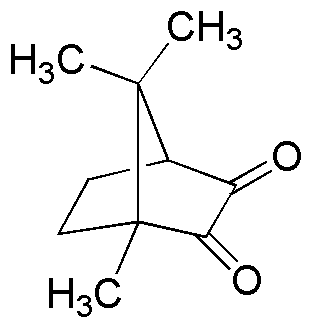Camphorquinone is widely utilized in research focused on:
- Dental Applications: It serves as a photoinitiator in dental materials, particularly in light-cured resins. Its efficiency in initiating polymerization under light exposure enhances the durability and strength of dental restorations.
- Cosmetic Formulations: Commonly found in cosmetic products, it acts as a UV filter and stabilizer, helping to protect skin formulations from degradation due to light exposure, thus improving product longevity.
- Photopolymerization Processes: In the field of 3D printing and additive manufacturing, it is used to initiate polymerization in resin-based systems, allowing for precise control over the curing process and enhancing the quality of printed objects.
- Pharmaceutical Development: It plays a role in the synthesis of various pharmaceutical compounds, particularly in the development of drug delivery systems, where its photoinitiating properties can be leveraged to control the release of active ingredients.
- Research in Material Science: Utilized in the development of advanced materials, camphorquinone is involved in creating photo-responsive polymers, which can change properties when exposed to light, opening avenues for innovative applications in smart materials.
Información general
Propiedades
Seguridad y normativas
Aplicaciones
Camphorquinone is widely utilized in research focused on:
- Dental Applications: It serves as a photoinitiator in dental materials, particularly in light-cured resins. Its efficiency in initiating polymerization under light exposure enhances the durability and strength of dental restorations.
- Cosmetic Formulations: Commonly found in cosmetic products, it acts as a UV filter and stabilizer, helping to protect skin formulations from degradation due to light exposure, thus improving product longevity.
- Photopolymerization Processes: In the field of 3D printing and additive manufacturing, it is used to initiate polymerization in resin-based systems, allowing for precise control over the curing process and enhancing the quality of printed objects.
- Pharmaceutical Development: It plays a role in the synthesis of various pharmaceutical compounds, particularly in the development of drug delivery systems, where its photoinitiating properties can be leveraged to control the release of active ingredients.
- Research in Material Science: Utilized in the development of advanced materials, camphorquinone is involved in creating photo-responsive polymers, which can change properties when exposed to light, opening avenues for innovative applications in smart materials.
Documentos
Hojas de datos de seguridad (HDS)
La SDS proporciona información de seguridad completa sobre la manipulación, el almacenamiento y la eliminación del producto.
Especificación del producto (PS)
La PS proporciona un desglose completo de las propiedades del producto, incluida la composición química, el estado físico, la pureza y los requisitos de almacenamiento. También detalla los rangos de calidad aceptables y las aplicaciones previstas del producto.
Certificados de análisis (COA)
Busque certificados de análisis (COA) ingresando el número de lote del producto. Los números de lote y de partida se pueden encontrar en la etiqueta de un producto después de las palabras "Lote" o "Lote".
Número de catálogo
Número de lote/lote
Certificados de origen (COO)
Este certificado de origen confirma el país en el que se fabricó el producto y también detalla los materiales y componentes utilizados en él y si se deriva de fuentes naturales, sintéticas u otras fuentes específicas. Este certificado puede ser necesario para cumplir con las normativas aduaneras, comerciales y regulatorias.
Número de catálogo
Número de lote/lote
Hojas de datos de seguridad (HDS)
La SDS proporciona información de seguridad completa sobre la manipulación, el almacenamiento y la eliminación del producto.
DownloadEspecificación del producto (PS)
La PS proporciona un desglose completo de las propiedades del producto, incluida la composición química, el estado físico, la pureza y los requisitos de almacenamiento. También detalla los rangos de calidad aceptables y las aplicaciones previstas del producto.
DownloadCertificados de análisis (COA)
Busque certificados de análisis (COA) ingresando el número de lote del producto. Los números de lote y de partida se pueden encontrar en la etiqueta de un producto después de las palabras "Lote" o "Lote".
Número de catálogo
Número de lote/lote
Certificados de origen (COO)
Este certificado de origen confirma el país en el que se fabricó el producto y también detalla los materiales y componentes utilizados en él y si se deriva de fuentes naturales, sintéticas u otras fuentes específicas. Este certificado puede ser necesario para cumplir con las normativas aduaneras, comerciales y regulatorias.


